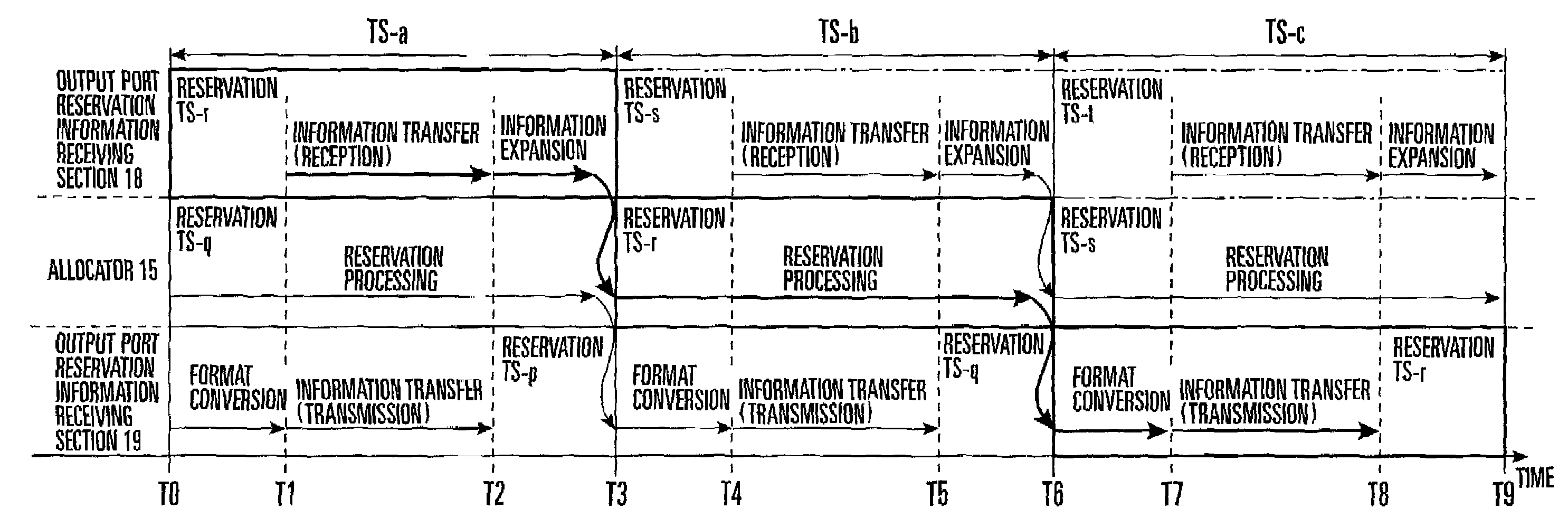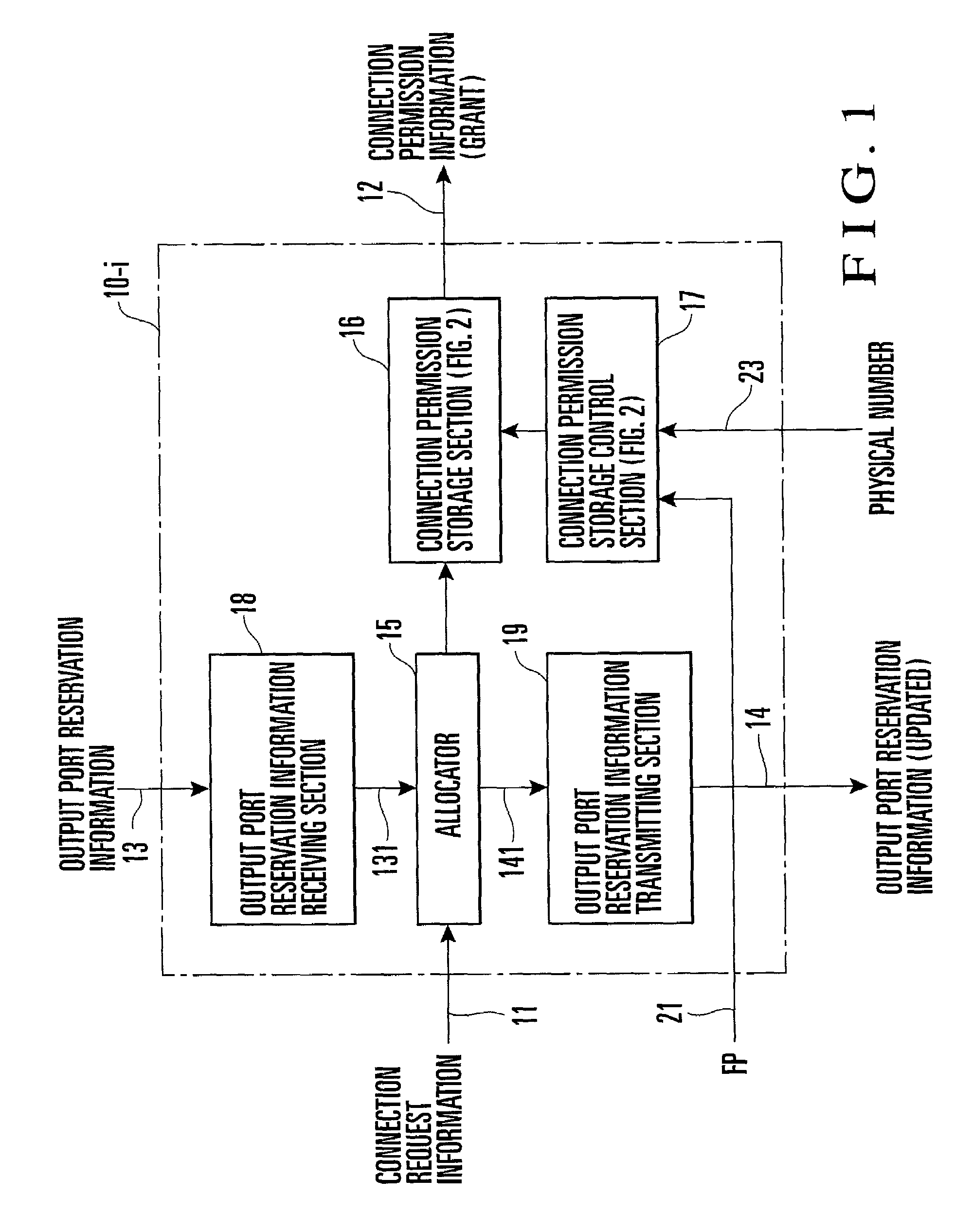Distributed pipeline scheduling method and system
a pipeline scheduling and distribution pipeline technology, applied in data switching networks, time-division multiplexing selection, multiplex communication, etc., can solve the problem of difficult to flexibly cope with an increase in severe limitations are imposed on the number of ports, and the number of terminals of the lsi becomes too large to integrate the ims into one lsi
- Summary
- Abstract
- Description
- Claims
- Application Information
AI Technical Summary
Benefits of technology
Problems solved by technology
Method used
Image
Examples
first embodiment
[0064]FIG. 4 shows scheduling operation of the present invention. This operation is scheduling operation based on framed RRGS. FIG. 4 shows case where module count N=4, and a method of determining a reservation sequence from TS9. The encircled time slot numbers (TS9 to TS20) indicate time slots that are reserved by a series of pipeline operations.
[0065]Time slots in which IM numbers (IM1 to IM4) are written indicate time slots in which reservation processing is executed. Time slots in which arrows are written indicate time slots in which format conversion processing, transfer processing, and expansion processing of reservation output port information are executed. The last curved arrow indicates a time slot as a reservation target.
[0066]Consider the correspondence between the operations in FIGS. 3 and 4. Referring to FIG. 4, for example, IM2 executes reservation processing for TS9 in the interval between TS2 and TS4. This corresponds to reservation processing for TS-r in the interva...
second embodiment
[0072]FIG. 5 shows scheduling operation in the present invention. This operation is also scheduling operation based on framed RRGS. FIG. 5 shows a case where module count N=4, and a method of determining a reservation sequence from TS9.
[0073]The following is the difference between this embodiment and the first embodiment of the present invention shown in FIG. 4. In the first embodiment, the combination of reservation time slots for which processing is started from TS1 are TS9, TS10, TS11, and TS12, and the combination of reservation time slots for which processing is started from TS2 are TS13, TS14, TS15, and TS16. In contrast to this, in this embodiment, reservation time slots for which processing is started from TS1 are TS9, TS11, TS13, and TS15, and reservation time slots for which processing is started from TS2 are TS10, TS12, TS14, and TS16.
[0074]As shown in FIG. 5, in the second embodiment as well, TS1 is a start reservation time slot. As in the first embodiment, connection re...
third embodiment
[0075]FIG. 6 shows scheduling operation in the present invention. This operation is scheduling operation based on RRGS. FIG. 6 shows a case where the number of modules used is an even number, i.e., N=4, and a method of determining a reservation sequence from TS9.
[0076]Scheduling for TS9 is started from a distributed scheduling module IM1 in TS1. In TS3, a distributed scheduling module IM2 performs reservation processing. In TS5, a distributed scheduling module IM3 performs reservation processing. In TS7, a distributed scheduling module IM4 performs reservation processing. In TS2, TS4, and TS6, transfer processing is performed. Subsequently, scheduling for TS10 is started from the distributed scheduling module IM4 in TS2. In TS4, the distributed scheduling module IM1 performs reservation processing. In TS6, the distributed scheduling module IM2 performs reservation processing. In TS8, the distributed scheduling module IM3 performs reservation processing. In TS3, TS5, and TS7, transfe...
PUM
 Login to View More
Login to View More Abstract
Description
Claims
Application Information
 Login to View More
Login to View More - R&D
- Intellectual Property
- Life Sciences
- Materials
- Tech Scout
- Unparalleled Data Quality
- Higher Quality Content
- 60% Fewer Hallucinations
Browse by: Latest US Patents, China's latest patents, Technical Efficacy Thesaurus, Application Domain, Technology Topic, Popular Technical Reports.
© 2025 PatSnap. All rights reserved.Legal|Privacy policy|Modern Slavery Act Transparency Statement|Sitemap|About US| Contact US: help@patsnap.com



